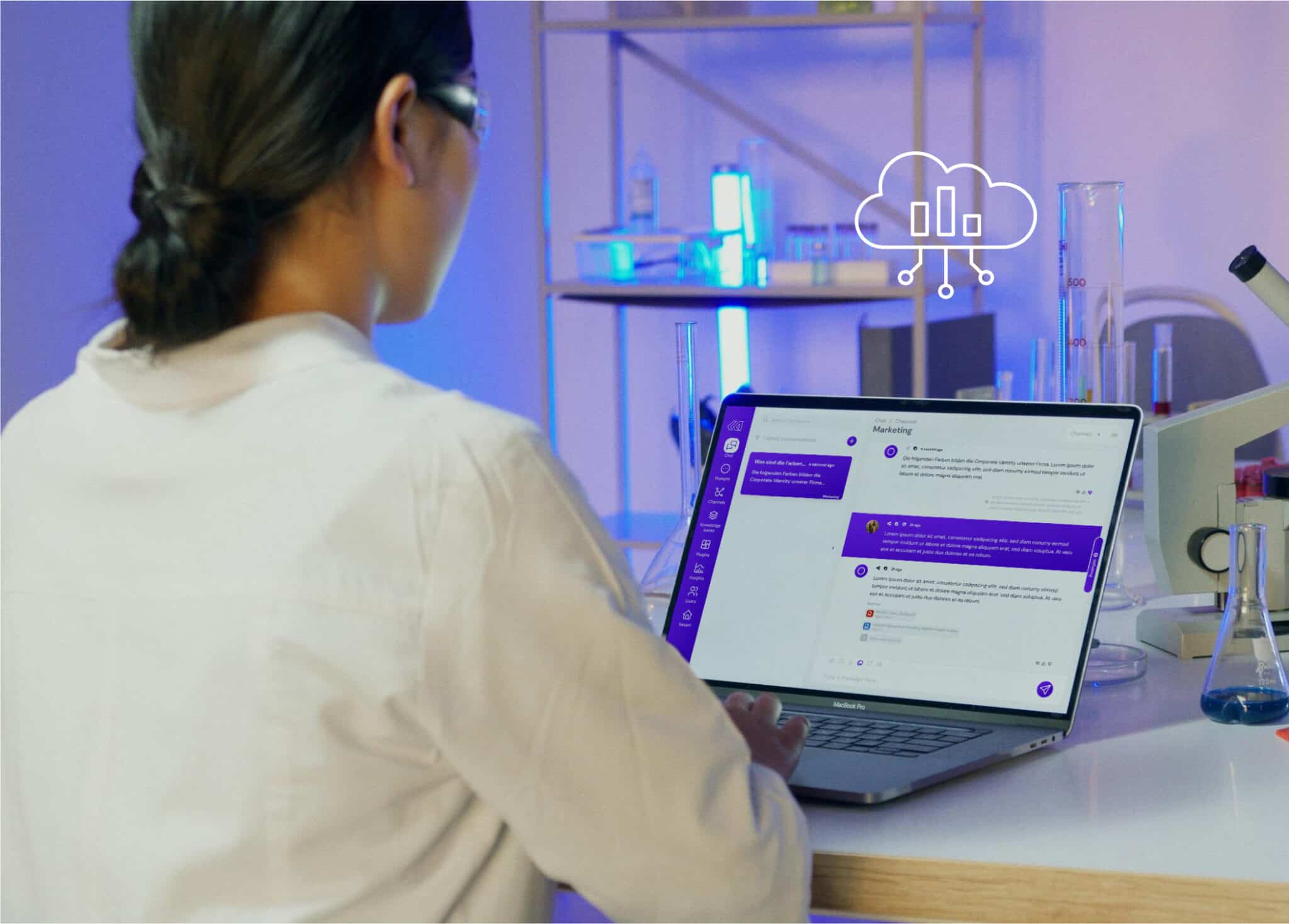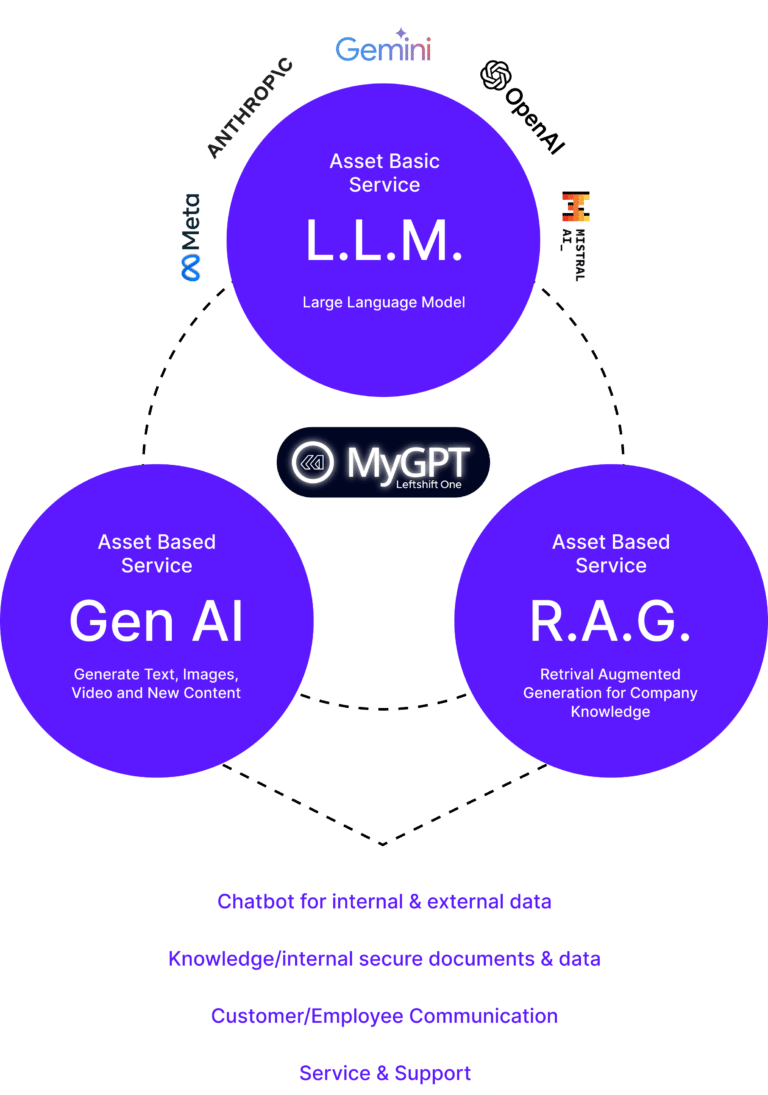More than Just Text Generation – How RAG is Revolutionizing Business
Today, companies need reliable and highly automated information to stay competitive in an increasingly dynamic digital environment. While traditional Large Language Models (LLMs) can generate impressive content, they often reach their limits when it comes to up-to-date information and factual accuracy.
This is where Retrieval-Augmented Generation (RAG) comes in: by combining generative artificial intelligence with information retrieval from defined data sources, RAG enables precise, transparent, and consistently current answers.
This article provides a comprehensive overview of the fundamentals of RAG technology, highlights its advantages over traditional LLMs, and illustrates with concrete examples why RAG is indispensable for data-sensitive industries. Finally, it introduces MyGPT by Leftshift One as a specialized RAG platform that supports companies in meeting compliance and data protection requirements with the highest security standards.
- 19. February. 2025

Patrick Ratheiser
Founder

What is Retrieval-Augmented Generation?
Retrieval-Augmented Generation is one of the most significant advancements in the field of generative AI models. While traditional Large Language Models can produce convincing text, they struggle when it comes to delivering current, fact-based, and precise answers. The phenomenon of hallucination – when AI generates invented or inaccurate content – poses a considerable risk, especially for companies with high compliance requirements.
1. The Importance of RAG for Today’s Businesses
Retrieval-Augmented Generation is one of the most important developments in generative AI. While traditional Large Language Models are capable of generating compelling text, they encounter difficulties when accurate, up-to-date, and fact-based responses are needed. The problem of hallucinations – where AI content is fabricated or incorrectly represented – presents a major risk, particularly for organizations with strict compliance requirements.
RAG addresses this issue by combining generative AI with targeted information retrieval. Instead of relying solely on pre-trained model knowledge, RAG provides relevant answers in real time from trusted data sources and integrates them with generated content. This enables accurate, context-specific, and verifiable results – a real advantage for businesses that depend on reliable information for their operations.
2. RAG for Sensitive Data and Compliance
Especially in industries with high demands for data security, compliance, and AI compliance, RAG is a true game-changer. Unlike traditional models, confidential information does not automatically flow into public training data with RAG. Instead, companies can define how and where sensitive data is processed.
Platforms like MyGPT by Leftshift One, which are based on RAG, create a more secure alternative to conventional AI solutions. They guarantee controlled access, transparent responses, and efficient data management – ensuring both data protection and the safeguarding of trade secrets.
The following section explains how Retrieval-Augmented Generation works in detail, why it outperforms traditional Large Language Models, and in which areas companies can benefit the most.

2.1 Fundamentals of Retrieval-Augmented Generation (RAG)
RAG explained
Retrieval-Augmented Generation (RAG) is an advanced method that combines generative AI with real-time information retrieval. While traditional Large Language Models (LLMs) rely solely on their extensive but static training data, RAG integrates up-to-date data sources flexibly into the generation process. This results in more precise, context-specific, and fact-based answers – a significant advantage for businesses that depend on reliable information.
The concept of RAG is based on two core components:
- Retrieval (targeted information retrieval):
The model actively searches predefined knowledge sources – such as company databases, documents, or websites – for relevant content. - Generation (answer creation):
The retrieved information is incorporated into the generated answer and linguistically refined, resulting in a clear, understandable, and contextualized response.
Through this symbiosis, RAG overcomes the limitations of traditional AI models. It is not restricted to pre-learned data but can continuously incorporate new information from trusted sources.
2.2 How Does RAG Differ from Traditional LLMs?
A key difference between RAG and traditional LLMs lies in the way knowledge is used. While conventional AI models rely solely on static training data, RAG can flexibly incorporate external information sources to deliver more substantiated answers.
The following table highlights the main differences between traditional LLMs and RAG models:
| Criterion | ChatGPT | RAG Model |
|---|---|---|
| Data basis | Static, based on training data | Dynamic, accesses external knowledge sources |
| Timeliness | Knowledge limited to training cut-off date | Generates answers with up-to-date information |
| Accuracy | May contain hallucinations | Fact-based and verifiable answers |
| Adaptability | Limited | Customizable to company-specific requirements |
| Transparency | Sources often not traceable | RAG provides specific sources for its answers |
As a result, RAG delivers more up-to-date, reliable, and often verifiable answers than conventional LLMs. For companies that place high value on AI compliance, timeliness, and factual accuracy, RAG represents a decisive step forward.
2.3 Why Is RAG Essential for Businesses?
In many business-critical processes, accurate, up-to-date, and verifiable information is crucial. From compliance management and the use of AI in sensitive industries to effective customer communication – wherever misinformation can cause significant harm, Retrieval-Augmented Generation is an indispensable tool.
Application examples:
- Internal knowledge bases: Instant access to company-specific data without the risk of information gaps.
- Customer support & chatbots: Context-aware answers to customer inquiries, based on current guidelines, compliance requirements, and company-specific best practices.
- Responsible data handling: Companies can clearly define which data is included, ensuring compliance with data protection and AI regulations.
2.4 How Retrieval-Augmented Generation (RAG) Works
How does RAG work in practice?
RAG is based on the intelligent combination of retrieval (targeted information search) and generation (the creation of human-like answers). Unlike purely generative AI systems that rely solely on their training knowledge, RAG additionally retrieves data in real time.
The key steps:
- Document retrieval (Retrieval)
- RAG scans predefined data sources such as company databases, cloud systems, or APIs for semantically relevant content.
- Using modern search algorithms (e.g., vector search), RAG also identifies contextually related information rather than relying only on exact search terms.
2. Contextual enrichment
- The retrieved data is processed, enriched, and condensed so that it fits the specific use case.
- This ensures that information from different sources is coherently connected and contextually aligned.
3. Answer generation (Generation)
- Based on the retrieved and enriched information, RAG generates a human-like, fact-based, and context-specific response.
Technological Foundations of RAG
Vector search: A technology that translates content into numerical vectors to identify semantic similarities.
Integration of defined data sources: Companies determine which knowledge bases (e.g., product databases, compliance guidelines, internal documents) RAG is allowed to search.
Feedback mechanisms: Through continuous training feedback, the relevance and quality of results can be continuously improved.
Example of the RAG Workflow
Suppose an employee asks:
“What are the current compliance requirements for AI systems in the EU?”
- Retrieval: RAG searches both company-owned databases and external EU documents for the latest information on AI regulations and compliance guidelines.
- Context enrichment: The retrieved text passages, such as from the EU AI Act, are summarized and adapted to the company-specific context.
- Answer generation: RAG provides a fact-based response such as:
“The EU AI Act sets out extensive transparency and security requirements for AI systems, particularly where there is a high risk to fundamental rights. These include regular audits, traceability of data processing, and strict reporting obligations.”

3. Advantages of RAG Compared to Traditional LLMs
Why RAG Outperforms Conventional LLMs
Retrieval Augmented Generation offers a range of clear advantages over conventional Large Language Models. In particular, RAG stands out in terms of accuracy, timeliness, and transparency.
- Fact-Based Answers
- Traditional LLMs sometimes hallucinate by generating non-existent data or irrelevant connections.
- RAG largely prevents this by reliably using real information from defined sources.
2. Data Timeliness
- LLMs are limited to knowledge up until their training cutoff date.
- RAG incorporates new content – e.g., current updates to an AI regulation – without lengthy retraining processes.
3. Flexibility and Adaptability
- RAG can integrate company-specific databases, industry-related documents, or external sources directly, without requiring a complete retraining of the model.
4. 4. Transparency and Traceability
- With traditional models, it is often unclear which data sources were used as the basis.
- RAG, on the other hand, shows exactly which sources the facts come from – a crucial factor for compliance requirements.
5. Efficiency in Specific Use Cases
- For certain knowledge-intensive queries, RAG delivers highly relevant and up-to-date information.
3.1 The Strengths of RAG
When a traditional LLM is asked, “What are the latest requirements of the EU AI Act?”, its answer might be outdated or incomplete. RAG, however, automatically searches public EU documents and a company’s own compliance guidelines, summarizes them, and presents a current, fact-based response with source references.
Conclusion: For companies that need reliable, fact-based, and regularly updated information, RAG is unbeatable.

4. Use Cases of Retrieval Augmented Generation
Why Companies Benefit from RAG
RAG is a versatile key technology that can be applied across various industries and processes. Whether in internal knowledge management, customer service, compliance workflows, or risk analysis—RAG delivers context-based answers with real-time relevance.
- Knowledge Management and Internal Information Systems
- Many companies manage large databases that are often not easily accessible to employees.
- RAG makes this data usable by enabling targeted searches and providing fast, accurate answers.
2. Customer Service and Chatbots
- Chatbots powered by RAG can handle highly specific customer inquiries by automatically retrieving FAQs, support tickets, or documentation.
- The results are not only linguistically optimized but also fact-based.
3. Compliance and Legal Support
- In regulated industries, frequent updates to laws and guidelines are part of everyday operations.
- RAG ensures that the relevant teams always have access to the latest, most reliable information.
4. Personalized Marketing and Sales Solutions
- With RAG, content can be dynamically tailored to customer and product information.
- This enables personalized offers that would otherwise require significant manual effort.
5. Cross-Industry Applications
- Healthcare: RAG can process medical guidelines or patient information.
- Finance: Dynamic analyses based on up-to-date market data.
- Education: Personalized learning materials for students.
Conclusion: Why RAG Is the Key to Efficient Processes
The real strength of RAG lies not only in providing accurate answers but also in data quality: companies can use their resources more effectively, reduce workload in knowledge management, and gain a clear competitive advantage in the market.
With RAG, you can allocate your resources more efficiently and reduce operational effort.
5. RAG and Data Security: Why MyGPT Is the Better Choice
Data Security in AI Systems
Especially when it comes to sensitive data, such as in healthcare, finance, pharmaceuticals, or the public sector, data protection is indispensable. While generative AI offers impressive possibilities, it also carries the risk of leaking information into external systems.
Retrieval Augmented Generation provides a clear advantage: since all data is retrieved from company-owned sources, RAG-based solutions can deliver controlled and verifiable responses from trusted databases.
5.1 How RAG Improves Data Security
- On-Premise and Private Cloud Solutions
- Companies retain full control over their data, as RAG instances can be hosted in secure cloud or local environments.
2. Precisely Defined Knowledge Sources
- Instead of searching the open internet, companies determine which databases or documents the system is allowed to access.
3. Traceability of Results
- Every answer can be traced back to its exact source, which is crucial for compliance and audit requirements.
4. No Storage of User Data
- Modern RAG platforms like MyGPT neither store input data nor generated outputs, minimizing the risk of data misuse.
5.2 Why MyGPT Is Particularly Secure
MyGPT by Leftshift One is the leading RAG platform designed to meet the highest security standards. The key advantages at a glance:
- EU Data Hosting: MyGPT is hosted in European data centers, ensuring GDPR compliance.
- Configurable Data Sources: Companies define precisely which knowledge sources MyGPT may access.
- Transparency: Every generated response cites its sources, providing clarity and fulfilling compliance requirements.
- Controlled Access: The integrated rights and role management ensures full control over access and data use.
Real-World Example
In a European hospital, medical staff needed up-to-date information from trusted sources. With MyGPT, doctors accessed the latest medical guidelines, studies, and clinical instructions securely—without the risk of sensitive patient data being exposed. The result: improved patient care and reduced administrative workload.
Seamlessly integrate MyGPT – unleash its full potential!
Implementation Guide: From configuration to go-live — start now and unlock the potential of generative AI!
Summary: RAG as a Key Technology for the Future
Retrieval Augmented Generation will continue to evolve and expand its impact in the areas of compliance management, AI adoption, and data protection. Thanks to platforms like MyGPT, companies already have access to innovative solutions that combine maximum data security with efficiency and cost-effectiveness.
- Accurate & up-to-date: RAG delivers fact-based answers in real time.
- Transparency & compliance: Clear source references and strict data usage rules ensure traceability.
- Adaptability: RAG is suitable for a wide range of industries, from healthcare and the public sector to finance and tech companies.
- Data security: Specific on-premise solutions, GDPR compliance, and fine-grained access rights ensure that sensitive information remains protected.
For companies investing in a future-proof AI strategy, Retrieval Augmented Generation is indispensable. This is particularly true for organizations that need to process sensitive data and minimize compliance risks — with RAG, they benefit from controlled, reliable, and transparent AI usage.
Curious to Learn More?
Discover how Retrieval Augmented Generation can be applied effectively in your organization. Contact us to learn more about MyGPT and tailored solution concepts. With RAG, you ensure that your AI adoption is secure, efficient, and truly future-ready.
Have you discovered our AI > Inside Podcast yet?
Alongside exciting insights into the mechanisms and potential of AI, the podcast also reveals what it really takes to make an AI project a success.